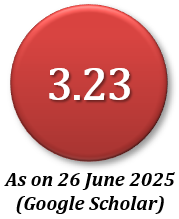Measuring Effectiveness of Non-Motorized Vehicles on Spatial Extent for TOD Development: A Case Study for MRT 6 in Dhaka
Abstract
To improve the effectiveness of conventional walking-based Transit-Oriented Development (TOD), introducing Non-Motorized Vehicles (NMV)-based TOD will be a more efficient alternative since it will increase the spatial extent of the TOD node’s buffer area. This paper discusses the available Bicycle-based TOD (BTOD) concept. Based on this concept, the spatial extent of NMV-based TOD (NTOD) has been calculated. A trip-based survey has been conducted on the selected regions of Dhaka along the line of MRT 6 regarding who uses NMV (Rickshaw, Bicycle) and public transport (PT) for his daily commuting. A trip chain analysis was performed first to capture the trip pattern of daily commuters. From the trip chain analysis, it has been found that PT-based trip chains dominated the city’s entire trip chain. Consequently, it has also been found that walking-only and walking-NVM accessible trips dominate 32% and 23% of the entire PT trip chains. However, based on the findings of trip chain analysis to calculate the spatial extent by developing regression models, it has been observed that the access trip length for walking ranges from 1.2-1.4 km, whereas the access trip length for NVM ranges from 4-4.7 km. In Dhaka, the catchment area of NTOD can increase the accessibility potentially by spatial extent expansion of about 70% fro m the conventional TOD. Therefore, it can be inferred that NVM will give more spatial accessibility than walking. As a result, a new window of planning and design strategies will be opened for the planners and policymakers around TOD station area planning considering NMV. Along with strategic recommendations, limitations, and future research agendas have also been discussed in this paper.
Downloads
References
BBS, & SID. (2015). Population Distribution and Internal Migration Bangladesh: Population Monograph, Volume-6.
Bertolini, L. (1999). Spatial Development Patterns and Public Transport: The Application of an Analytical Model in the Netherlands. Planning Practice and Research, 14(2), 199–210. https://doi.org/10.1080/02697459915724
Black, J. (1996). Higher Density Housing and Transport in Australian Cities BT - Transport, Land-Use and the Environment (Y. Hayashi & J. Roy, Eds.; pp. 55–80). Springer US. https://doi.org/10.1007/978-1-4757-2475-2_4
Calthorpe, P. (1993). The Next American Metropolis; Ecology, Community, and the American Dream. Princeton Architectural Press.
Cervero, R. (2002). Built environments and mode choice: Toward a normative framework. Transportation Research Part D: Transport and Environment, 7(4), 265–284. https://doi.org/10.1016/S1361-9209(01)00024-4
Cervero, R., & Dai, D. (2014). BRT TOD: Leveraging transit oriented development with bus rapid transit investments. Transport Policy, 36, 127–138. https://doi.org/10.1016/j.tranpol.2014.08.001
Cervero, R., & Day, J. (2008). Suburbanization and transit-oriented development in China. Transport Policy, 15(5), 315–323. https://doi.org/10.1016/j.tranpol.2008.12.011
Cervero, R., & Kockelman, K. (1997). Travel demand and the 3Ds: Density, diversity, and design. Transportation Research Part D: Transport and Environment, 2(3), 199–219. https://doi.org/10.1016/S1361-9209(97)00009-6
Chen, Z., Li, P., Jin, Y., Bharule, S., Jia, N., Li, W., Song, X., Shibasaki, R., & Zhang, H. (2022). Using mobile phone big data to identify inequity of aging groups in transit-oriented development station usage: A case of Tokyo. Transport Policy.
Curtis, C., & Scheurer, J. (2017). Performance measures for public transport accessibility: Learning from international practice. The Journal of Transport and Land Use, 10(1), 93–118. http://dx.doi.org/10.5198/jtlu.2016.683
Deng, X., Zhang, J., Liao, S., Zhong, C., Gao, F., & Teng, L. (2022). Interactive Impacts of Built Environment Factors on Metro Ridership Using GeoDetector: From the Perspective of TOD. ISPRS International Journal of Geo-Information, 11(12), 623.
Dey, A. C., Roy, S., & Uddin, M. A. (2018). Calibration and validation of Vissim model of an intersection with modified driving behavior parameters. International Journal of Advanced Research (IJAR), 6(12), 107–122. https://doi.org/10.21474/IJAR01/8120
Hino, S., Kishi, K., Satoh, K., & Chiba, H. (2000). Roles and persistence measures of rail freight transportation between Hokkaido and Honshu. Infrastructure Planning Review, 17, 827-834.
JICA, & DTCA. (2015). The Project on the Revision and Updating of the Strategic Transport Plan for Dhaka, Urban Transport Policy (draft)
Jin, Y., Li, P., Chen, Z., Bharule, S., Jia, N., Chen, J., Song, X., Shibasaki, R., & Zhang, H. (2023). Understanding railway usage behavior with ten million GPS records. Cities, 133, 104117.
Lee, J., Choi, K., & Leem, Y. (2016). Bicycle-based transit-oriented development as an alternative to overcome the criticisms of the conventional transit-oriented development. International Journal of Sustainable Transportation, 10(10), 975–984. https://doi.org/10.1080/15568318.2014.923547
Li, C.-N., & Lai, T.-Y. (2009). Why should cities change from DOT to TOD? Proceedings of the Institution of Civil Engineers - Transport, 162(2), 71–78. https://doi.org/10.1680/tran.2009.162.2.71
Lin, J. J., & Gau, C. C. (2006). A TOD planning model to review the regulation of allowable development densities around subway stations. Land Use Policy, 23(3), 353–360. https://doi.org/10.1016/j.landusepol.2004.11.003
Nelson, D., & Niles, J. S. (1999). Market Dynamics and Nonwork Travel Patterns; Obstacles to Transit-Oriented Development? Transportation Research Record: Journal of the Transportation Research Board, 1669(1), 13–21. https://doi.org/10.3141/1669-02
Rastogi, R., & Rao, K. V. K. (2003). Travel Characteristics of Commuters Accessing Transit: Case Study. Journal of Transportation Engineering, 129(6), 684–694. https://doi.org/10.1061/(ASCE)0733-947X(2003)129:6(684)
Samimi, A., Mohammadian, A., & Madanizadeh, S. (2009). Effects of transportation and built environment on general health and obesity. Transportation Research Part D: Transport and Environment, 14(1), 67–71. https://doi.org/10.1016/j.trd.2008.10.002
Su, S., Zhang, H., Wang, M., Weng, M., & Kang, M. (2021). Transit-oriented development (TOD) typologies around metro station areas in urban China: A comparative analysis of five typical megacities for planning implications. Journal of Transport Geography, 90, 102939.
Tecnica Y Proyectos SA (TYPSA). (2020). Feasibility Study and Preliminary Design for Construction of Dhaka Subway.
Timpabi, A. P., Osei, K. K., & Adams, C. A. (2021). Bicycle ownership and utilization in Tamale Metropolis; influencing factors and impacts to sustainable transport. Heliyon, 7(6), e07133.
Uddin, M. A., Hoque, M. S., Tamanna, T., Adiba, S., Muniruzzaman, S. M., & Parvez, M. S. (2023). A framework to measure transit-oriented development around transit nodes: Case study of a mass rapid transit system in Dhaka, Bangladesh. Plos One, 18(1), e0280275.
Uddin, M. A., Roy, S., & Hoque, M. S. (2019). Effect Of City Bus Behavior On Pedestrian Road Crossing At Intersections In Non-Lane Based Heterogenous Traffic Condition. Asian Journal of Behavioural Sciences, 1(2), 9–16.
World Bank. (2019). World Bank Open Database. https://data.worldbank.org/
Xiao, W., & Wei, Y. D. (2023). Assess the non-linear relationship between built environment and active travel around light-rail transit stations. Applied Geography, 151, 102862.
Yen, B. T., Feng, C.-M., & Lee, T.-C. (2023). Transit-oriented development strategy in Taiwan: An application of land value capture. Asian Transport Studies, 9, 100094.
MIJST follows the open access policy.

This work is licensed under a Creative Commons Attribution-NonCommercial 4.0 International License. This allows anyone to copy, share, distribute, and modify the work for non-commercial purposes, where the original work and source should be properly credited.
















